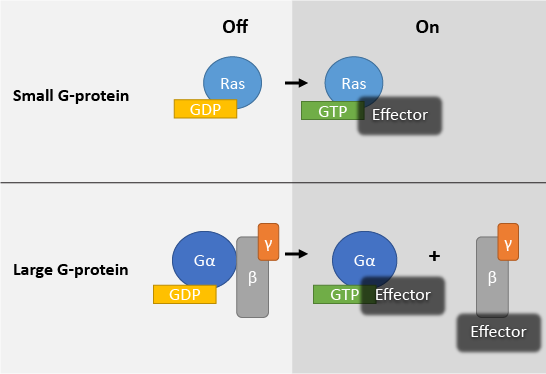Two types of G-proteins

G-proteins: On/off Switches of the Cell
G-proteins are cellular on/off switches. Much like there are many different types of on/off switches in your house, living room light switches, kitchen light switches, fan switches, refrigerator switches, or stove switches, there are many different types of G-proteins, controlling a huge variety of cellular processes, but each one works fundamentally the same way.
When bound to the nucleotide GDP, G-proteins are generally in the “Off” position. They are turned on by proteins called Guanine nucleotide Exchange Factors (GEFs) that cause the G-protein to let go of GDP, and pick up a GTP. When bound to the nucleotide GTP, G-proteins are generally in the “on” position. In this configuration, they are capable of interacting with their effector proteins and signaling.
Small G-proteins are members of the Ras superfamily of small GTPases. They are also referred to as monomeric G-proteins, as they, wait for it…. exist as monomers.
Large G-proteins are also called heterotrimeric G-proteins, because they consist of three subunits, Gα, Gβ, and Gγ. Gα is the subunit most like small G-proteins, it will bind to GDP and GTP. When it is bound to GTP, the Gα will release the Gβ/Gγ dimer. Free Gα and free Gβ/Gγ are then able to bind effectors and initiate signaling.
Large G-protein Dependent Processes
- Taste/Smell
- Sight
- Neurotransmission
- Neutrophil tracking of invading bacteria
- Tissue Development
- Allergic Reactions
- Cancer Metastasis
